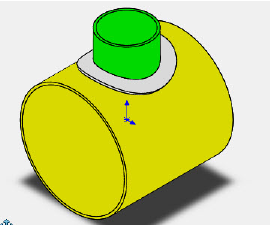A pad is a pad is a pad, right? Wrong! But we're the wear pad people, right? Well, not exactly. We’re known for our wear pads and pipe supports, but that's not all that customers request. They send us all sorts of requests, and one of the items we’re frequently asked about is repads.
If you don’t know what a repad is, you’re not alone. I wasn't very familiar with these when we first started selling them, but now they're something we handle for customers pretty frequently. At this point, you're probably asking, “What the heck is a repad?” Read on. We’ve outlined what these supports are all about and how they relate to other pads.
What Exactly Is a Repad?
 Wondering what a repad is? The quick and dirty answer is that a repad is a reinforcing pad. As you may have guessed from the name, a repad is used to reinforce or strengthen a high-stress point on your pipe.
Wondering what a repad is? The quick and dirty answer is that a repad is a reinforcing pad. As you may have guessed from the name, a repad is used to reinforce or strengthen a high-stress point on your pipe.
The product itself looks like a doughnut or a big washer. It wraps around a new piece of pipe at a point where you’re joining that new section of pipe to another—essentially forming a T. This important junction, where there’s especially high stress, is usually called a “stub-in.”
*Image by PVEng
Why bother with a stub-in?
Pipe stub-ins allow you to weld a branch connection pipe right onto your main pipe by welding a perpendicular leg onto a section of your pipe. What’s the advantage of this? Basically, you can avoid buying and installing a three-way pipe fitting or adding three separate welds.
Instead, with a stub-in, you can attach the intersecting pipes with one single weld. The repad adds strength at the single weld point at the base of the stub-in.
Repads vs. Wear Pads
Well you might be wondering, “How is a repad so different from a wear pad?” It's massively different.
First of all, wear pads serve a fundamentally different purpose. They add insulation and wear protection to existing piping. They act as a protective barrier between the pipe and surrounding support beams or surfaces. That means you can use wear pads to stop metal-on-metal corrosion or the damage that occurs when unprotected pipes scrape against metal or concrete surfaces.
Also, wear pads are much simpler to install. They don’t require any welding. In fact, they’re fixed to pipes with an extremely strong epoxy adhesive. That means you can install the wear pad before or after you add paint or coatings to pipes, as well as during fabrication, or right in the field.
Repads, on the other hand, are a bit more complex and important in the grand scheme of things.
First off, installation is much more complicated. It requires cutting a hole in your main pipe, adding your connecting pipe, fitting your repad around your connecting pipe like a saddle, and welding the pad directly onto the main pipe.
As you may have guessed, there are more complications that come with cutting large holes in your pipes. This can lead to hole weakening and stress concentration. That’s why repads also require pipe stress analysis to determine if the weakening from cutting open the pipe and then joining them has created a potential hazard in the piping system.
Secondly, they’re not the easiest things to draft up and draw once an engineer has decided one is needed. Pressure Vessel Engineering (PVEng) even has tips and tricks on how to use different commands to draw and design repads in pipe stress software.
Advantages and Disadvantages of Reinforcement Pads
Didn’t realize how complicated these pads were? Don’t worry: Like you, I didn't think these pads were all that complicated, but once I started digging into them, I noticed that they’re no picnic to put in on your own.
The biggest disadvantages of repads are the precision and labor involved. In order to avoid dissimilar metal corrosion or weak spots, you’ll also want your repad to be made of a material that matches your original pipe. Its thickness should fit the size of your original pipe, and accurate measurements and cuts are a must.
However, if you need to add a tee joint, repads can work as an important layer of support for an otherwise vulnerable connection point. Without them, you’d be left with a dangerously weak perimeter cut around a point where pressure can build up. That makes them an important part of keeping a plant safe and running smoothly without leaks. Plus, if installed correctly, you’ll be saving yourself the trouble of welding and reinforcing three separate points.
Need Help on Your Next Repad Order?
Want assistance with an upcoming repad job? We want to help. Contact us here for a fast quote or to ask us a question about your next project.






